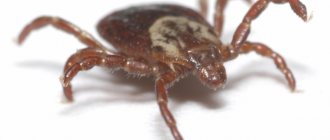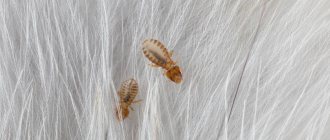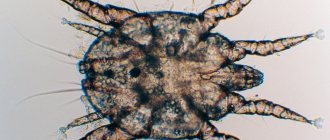When purchasing a pet, you must make sure that it is in absolutely healthy condition. You need to find out everything from the seller, and also examine the pet yourself. Suitable and proper care is important for any animal; if it is not provided, the guinea pig may become ill or become infected with parasites. Ticks can cause serious harm. They are found in the fur, on or under the skin.
How to tell if your guinea pig has subcutaneous mites
The subcutaneous mite in a guinea pig is a parasite that lives under the skin of very small sizes. A pet can acquire ticks from contact with another pig and not show that it is infected for a long time. The parasite is activated when immunity decreases. For this reason, ticks are most often found in children, old individuals, pregnant females and pets that are kept in improper conditions.
To identify the disease, you need to do a scraping. He may give an incorrect result, saying that the animal does not have parasites. Larvae can be seen only in half of the possible cases. But if symptoms of infection appear, then treatment must be started immediately. Owners may confuse parasite infection with an allergic reaction. However, if the pet really has an allergy, then signs of the disease do not appear.
Demodicosis
The disease occurs when infected by blood-sucking microscopic mites belonging to the genus Demodex. These parasites settle inside the hair follicles and near them on the skin.
Infection occurs through contact with sick individuals. Often, a sick female's cubs also become ill.
A sign of the disease is the appearance of characteristic nodules and suppurating rash spots at the sites of bites on the scalp and paws. Areas affected by mites become bald. Due to numerous bites, a guinea pig's paws may swell, causing the animal to limp slightly.
Demodicosis is diagnosed in the laboratory by examining skin scrapings.
Treatment is carried out strictly under the supervision of a veterinarian. The drug, ivermectin, is very toxic - its overdose threatens the death of the animal.
Infection and manifestation
For guinea pigs, the greatest danger is the subcutaneous mite. It causes the animal to experience severe itching and constantly itch, sometimes until it bleeds. After this, hair falls out in the foci of the disease. You may notice a decrease in appetite, which can cause the body to become exhausted. At first the pet will behave restlessly, and then become apathetic. When immunity decreases, the tick begins to attack. Most often, old, pregnant and young individuals become infected. If you do not treat and let the disease take its course, then, most likely, the pet will soon die, being exhausted and poisoned.
Symptoms
The main sign of parasite infection is severe itching, pain and hair loss in areas of the skin. Sometimes the skin may begin to peel, the animal becomes irritated if touched and noticeably loses weight. If you touch the source of infection, the pig will feel discomfort and pain.
Therefore, the pet will begin to itch and try to gnaw its own body, which will cause even more harm and unnecessary problems in the form of large scratches and damage. The disease is best tolerated by healthy pigs; sick pets or young animals are much more difficult to tolerate infection.
Symptoms of the appearance of subcutaneous mites in a furry pet:
- severe shedding;
- the color of the wool becomes dull;
- dandruff forms;
- the animal scratches its skin bleeding;
- alopecia occurs;
- infected areas of the skin itch unbearably.
Parasitic diseases of guinea pigs
Sarcoptic mange is a skin disease caused by subcutaneous mites that settle in the germ layer of an animal's skin. Ticks move from the skin of a sick animal to a healthy individual and gnaw a passage into the epigium layer. The process of gnawing through the upper layers of the epithelium gives the pig a lot of unpleasant sensations: itching, restlessness, and the formation of growths. When diagnosing sarcoptic mange, the animal is prescribed appropriate medications. Confirmation of the diagnosis occurs after scrapings are taken and tested in the laboratory.
Trixacarosis is an infection with the Trixacarosis cawi mite. This parasite causes itching by its actions, which drives animals crazy. The animals stop eating, drinking, and scratch their bites until they are wounded. Prolonged course of the disease causes a decrease in immunity, which leads to miscarriages and disorientation. If left untreated, the animal dies from a lack of fluid in the body or from an infection that the weakened body is unable to overcome.
Confirmation of the diagnosis occurs as a result of laboratory analysis of scrapings. Medicines are prescribed by a specialist.
Fleas, lice and lice are parasites that cause no less concern than ticks. Their bites cause irritation, the animal itches and becomes restless. These parasites are dangerous to other pets and humans. The parasites themselves and their nits can be seen with the naked eye in the animal’s fur and on its body. Treatment is carried out with special drugs prescribed by a doctor.
Worms. All domestic animals are susceptible to infection with worms. Helminth eggs enter the body through water, food and on the paws of pets that are walked outside. Symptoms of infection are: refusal to eat, eating disorders, weight loss, lethargy.
To treat helminthic infestation, the animal is prescribed anthelmintic drugs.
Treatment of subcutaneous mites in guinea pigs
Suitable treatment is prescribed by a professional veterinarian. Initially, a tick infestation is diagnosed by scraping. If the analysis shows no evidence of the presence of a parasite, then the doctor can begin treatment based on the symptoms. If the animal is still very young and therefore not properly tamed, then it is better not to scrape it. Because of this, stress may develop, and then the well-being of the sick rodent will worsen. It is important to remember that your pet may have more than one disease, but several, which worsen the pig’s well-being. In addition to the subcutaneous type of parasites, there are also ear mites in guinea pigs, as well as other diseases that can baffle even doctors with extensive experience. The initial stages of treatment are carried out under the constant supervision of a veterinarian.
You can treat your guinea pig against ticks with Ivermectin injections. Injections are given once a week, the dose of medication is calculated based on the pet’s weight. To cure cubs weighing less than three hundred grams, Otodectin is used. Its dose is also calculated depending on the individual parameters of the individual.
Prevention of infection of guinea pigs with ectoparasites
To prevent guinea pigs from becoming infected with ectoparasites, it is necessary to follow simple preventive measures:
- feed guinea pigs a balanced diet using vitamin preparations to strengthen the animals’ immunity; treat guinea pigs that are walked in the outdoor environment with insecticidal sprays, and use special flea shampoos when bathing; purchase filler, feed and hay only in specialized stores; wash your hands and change your street clothes before interacting with your beloved pet.
Insect parasitism, if left untreated, can cause progressive exhaustion or death of a pet. If itching and restlessness appear in your guinea pig, it is recommended to immediately begin treatment under the supervision of a veterinarian.
After treatment
When infection with a subcutaneous parasite is confirmed, the pet needs treatment, and its home needs careful treatment. To ensure that parasites no longer spread, it is necessary to create a quarantine and immediately treat animals that show signs of illness.
The situation will not improve in a matter of moments, so you need to be patient. It is possible to completely cure your pet only after 2–4 weeks, it all depends on the severity of the disease. It is best to add useful elements to your pet’s diet to strengthen the immune system. Try not to use flea and insect repellents - most of them contain pesticides that are dangerous to rodents.
Are ticks dangerous for people?
The harmful mite in guinea pigs does not pose a danger to humans. It exclusively infects guinea pigs.
Advice seventh. Prevention of parasites
Guinea pigs, like all animals, can easily pick up various parasites.
They find refuge both on the pets themselves and inside the body. Guinea pigs are often chosen as “hosts” by fleas, lice, and even ticks. So you need to be prepared for literally anything. You will quickly realize that your pet is infected with a tick - the animal will begin to scratch, literally hurting itself. In turn, deep scratches themselves carry the risk of secondary bacterial infections. Further, the situation develops like an avalanche, so it is extremely important to establish the real cause in time.
Lice, if they are present on your pet, are almost always found on its face (there are especially many lice behind the ears). Fleas also cause a lot of trouble for animals. We warn you that removing parasites yourself (especially from such fragile animals as guinea pigs) is not a completely successful idea. It is better to show the animal to the veterinarian and ask his advice. The doctor will always suggest the most effective and affordable means.
Care instructions
Try to change your pet's living conditions and diet. His house should be free and clean. Remember to regularly clean your pet's cage. Even the most comfortable house gets boring over time, so you need to periodically let the animal out to walk around the room and play with it.
Guinea pigs do not like sharp and loud sounds, so it is better to place their home in a quiet corner. There should always be food, useful elements and clean water inside. Make sure that water can flow from the waterer before placing it in the cage.
If a pet is infected with parasites, then this ultimately leads to sad consequences. If you notice that the animal is itching and is acting restless, then you need to start treating it immediately. Treatment is carried out under the supervision of a veterinarian. Remember that by providing your pet with favorable living conditions, you reduce the risk of parasite infection.
Source
Endoparasites
Endoparasites are parasites that live in the internal organs of a guinea pig. They cause great harm to health and cause not only various poisonings, but also lead to disruption of the functioning of internal organs, as well as the death of the animal. Most often, a guinea pig suffers from:
- worms,
- liver flukes.
Worms
These parasites not only absorb nutrients, but also lead to intoxication and depletion of the body. Typically, guinea pigs are susceptible to infection with two types of worms:
- tape or flat,
- round.
Adult flatworms are parasitic in the intestines and have a ribbon-shaped body. The embryos of worms, having entered the animal’s body along with low-quality food, can drill through the wall of the small intestine and enter the blood. They are able to move freely throughout the body through the circulatory system and settle in the lungs, liver, and brain, which will lead to the rapid death of the animal. Worm larvae are dangerous not only for guinea pigs, but also for humans. An infected animal can be easily identified by lethargy and drowsiness, weight loss, increased appetite and thirst. If the infection is severe, then in the animal’s feces you can see not only worm larvae, but also adult individuals. And with a very severe infection, worms can crawl out of the anus.
Roundworms vary in appearance and can be shaped like a thin thread or a grain of rice. Some are whitish in color and some are pink. Parasites most often live in the intestines, lungs and liver. They lead to exhaustion and blood poisoning, as well as frequent digestive problems and poisoning. Before starting treatment for any type of worms, you should visit a veterinarian to determine the degree of infection. If there are a lot of parasites, special supportive and immune medications may be required. However, if the infection is not severe, then it is enough to give the pig a suspension of prazicide for kittens at the rate of one milliliter per kilogram of the guinea pig’s weight. Dirofen paste has proven itself well. Along with giving the medicine, it is necessary to completely treat the cell with a chlorine-containing solution.
Liver fluke
The liver fluke is one of the most common and dangerous representatives of the species of liver flukes that parasitize the body of mammals. An animal can become infected with this parasite through poorly washed food, as well as through dirty water. Symptoms indicating fluke infection are loss of appetite, as well as lethargy, drowsiness and increased body temperature. Within a month, symptoms may completely disappear, but the parasite will continue to exist inside the liver. Gradually, liver tissue will be destroyed, metabolism will be disrupted, and blood poisoning may occur. Often the liver fluke causes the death of a guinea pig.











